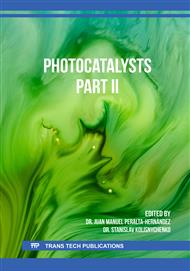[1]
I.E.T.E.G. (IETEG), Chromium (VI) Handbook. United States of America, CRC Press, (2005).
Google Scholar
[2]
M. Barakat, New trends in removing heavy metals from industrial wastewater, Arabian Journal of Chemistry. 4(4) (2011) 361-377.
DOI: 10.1016/j.arabjc.2010.07.019
Google Scholar
[3]
Y. Xu and M.A. Schoonen, The absolute energy positions of conduction and valence bands of selected semiconducting minerals, American Mineralogist. 85(3-4) (2000) 543-556.
DOI: 10.2138/am-2000-0416
Google Scholar
[4]
A. Hernández-Ramírez and I. Medina-Ramírez, Photocatalytic Semiconductors: Synthesis, Characterization, and Environmental Applications. Switzerland, Springer, (2015).
DOI: 10.1007/978-3-319-10999-2
Google Scholar
[5]
J. Kim, C.W. Lee, and W. Choi, Platinized WO3 as an environmental photocatalyst that generates OH radicals under visible light, Environmental Science & Technology. 44(17) (2010) 6849-6854.
DOI: 10.1021/es101981r
Google Scholar
[6]
A.K. Nayak, et al., Crystal phase and size-controlled synthesis of tungsten trioxide hydrate nanoplates at room temperature: Enhanced Cr(VI) photoreduction and methylene blue adsorption properties, ACS Sustainable Chemistry & Engineering. 5(3) (2017) 2741-2750.
DOI: 10.1021/acssuschemeng.6b03084.s001
Google Scholar
[7]
S. Adhikari, D. Sarkar, and H.S. Maiti, Synthesis and characterization of WO3 spherical nanoparticles and nanorods, Materials Research Bulletin. 49(2014) 325-330.
DOI: 10.1016/j.materresbull.2013.08.028
Google Scholar
[8]
A. Watcharenwong, et al., Anodic growth of nanoporous WO3 films: Morphology, photoelectrochemical response and photocatalytic activity for methylene blue and hexavalent chrome conversion, Journal of Electroanalytical Chemistry. 612(1) (2008) 112-120.
DOI: 10.1016/j.jelechem.2007.09.030
Google Scholar
[9]
Y. Baek and K. Yong, Controlled growth and characterization of tungsten oxide nanowires using thermal evaporation of WO3 powder, The Journal of Physical Chemistry C. 111(3) (2007) 1213-1218.
DOI: 10.1021/jp0659857
Google Scholar
[10]
M.W.a.W.-D. Schubert, The beautiful colours of tungsten oxides, Tungsten Newsletter. (2013).
Google Scholar
[11]
X. Huang, et al., On the structure and chemical bonding of tri-tungsten oxide clusters W3O n-and W3O n (n= 7− 10): W3O8 as a potential molecular model for O-deficient defect sites in tungsten oxides, The Journal of Physical Chemistry A. 110(1) (2006) 85-92.
DOI: 10.1002/chin.200612001
Google Scholar
[12]
L. LeGore, et al., Controlled growth of WO3 films, Journal of Vacuum Science & Technology A: Vacuum, Surfaces, and Films. 15(3) (1997) 1223-1227.
DOI: 10.1116/1.580599
Google Scholar
[13]
G.D. Rieck, Tungsten and Its Compounds, 1st ed. Britain, Pergamon Press, (1967).
Google Scholar
[14]
I.M. Szilágyi, et al., WO3 photocatalysts: Influence of structure and composition, Journal of Catalysis. 294(2012) 119-127.
Google Scholar
[15]
N. Bashirom, et al., Sunlight activated anodic freestanding ZrO2 nanotube arrays for Cr(VI) photoreduction, Nanotechnology. 29(37) (2018) 375701.
DOI: 10.1088/1361-6528/aaccbd
Google Scholar
[16]
T. Tatarchuk, et al., Photocatalysis: Activity of nanomaterials, in Nanotechnology in Environmental Science, C.M. Hussain and A.K. Mishra, Editors, Wiley-VCH: Weinheim, Germany, 2018, p.244.
Google Scholar
[17]
N. Bashirom, et al., Anodic ZrO2 nanotubes for heavy metal ions removal, in 1-Dimensional Metal Oxide Nanostructures: Growth, Properties, and Devices, Z. Lockman, Editor, CRC Press: Boca Raton, 2019, pp.143-178.
DOI: 10.1201/9781351266727-6
Google Scholar
[18]
P. Vanysek, Electrochemical series, Handbook of Chemistry and Physics. 88(2000).
Google Scholar
[19]
N. Bashirom, K.A. Razak, and Z. Lockman, Synthesis of freestanding amorphous ZrO2 nanotubes by anodization and their application in photoreduction of Cr(VI) under visible light, Surface and Coatings Technology. 320(2017) 371-376.
DOI: 10.1016/j.surfcoat.2016.12.026
Google Scholar



